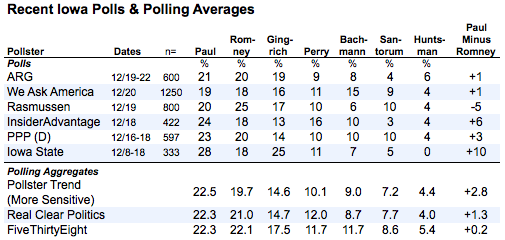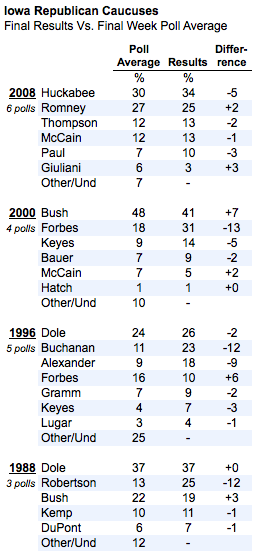At this rate I’ll never get my grading done.
Two more polls just in and (fortunately!) they are consistent with my earlier analysis posted today. The first poll is a Rasmussen automated survey conducted Dec. 28, and the second is a telephone survey by American Research Group (ARG) from Dec. 26-28 (both polls have a margin of error +/-4%). For ease of interpretation I’ve put the five most recent Iowa polls in the following table. (Note, however, that the CNN poll took place with a day off for the Christmas holidays.)
| Candidate | Public Policy Polling (12. 26-27.11) | CNN (12.21-24, 12.26-27.11) | Insider Advantage(12.28.11) | American Research Group (12.26-28.11) | Rasmussen (12.28.11) |
| Romney | 20% | 25% | 17.2% | 22% | 23% |
| Paul | 24% | 22% | 17.3% | 16% | 22% |
| Gingrich | 13% | 14% | 16.7% | 17% | 13% |
| Santorum | 10% | 16% | 13.4% | 11% | 16% |
| Perry | 10% | 11% | 10.5% | 9% | 13% |
| Bachmann | 11% | 9% | 11.8% | 8% | 5% |
Once you account for differences in sampling and the dates of these polls, they tell somewhat similar stories. Keeping in mind all the usual caveats about polling a caucus state, what do these more recent surveys suggest is happening in Iowa today, five days before voting? I offer the following observations.
- Romney is going to get about 23% of the vote, give or take a few percentage points. That is, he’ll finish close to what he did four years ago. Whether that is enough to win depends on several other factors. See below.
- Paul’s support, I think, may be softening just a bit, probably because of doubts, fueled by negative campaign ads, regarding his foreign policy views. Note that his unfavorable ratings have risen in the last week and are now in negative numbers. Of course, with him it all depends on the relevant turnout of independents and younger voters. Will the college crowd be home for the winter break? Will they turn out? We know that he has a core group of supporters who will show up no matter what. But I don’t think that constitutes much more than 20% of likely voters.
- Gingrich seems to have weathered the avalanche of negative ads directed at him and is stabilized at about 16%. In my view, he has a greater potential upside than either Romney or Gingrich, primarily because his support cuts across demographic and party lines. His biggest problem is extremely high unfavorable ratings. Much depends on whether his last-minute advertising pitch can swing voters his way. He is now, finally, on the air with new television ads. Unlike Romney and Paul, however, he lacks a campaign infrastructure for getting out the vote.
- Santorum seems to be benefitting from the “last Christian standing” dynamic; the evangelicals have danced with everyone else not named Mitt or Ron at least once (please, no touching on the dance floor), so it now appears to be Santorum’s turn. He’s peaking at the right moment, has high favorable ratings (because no one has bothered to attack him) and could challenge for third place.
- Perry is a wildcard – he’s blanketed the state with advertising and has made a strong pitch for the conservative vote but it’s not clear that he’s attracting more than 12% support.
- Bachmann is in danger of getting winnowed. The key question, for me, is whether her supporters peel off in the caucus room and switch to Santorum. Note that unlike in Democratic caucusing in Iowa, where there’s plenty of jockeying for position, there’s not a lot persuasion that goes on in the Republican meetings, and the vote is by secret ballot. So it’s a lot easier to dump the one you brought to the dance.
The results five days from now, it seems to me, hinge on two factors. What is the relative percentage of independents (and even Democrats) that turn out? And do the evangelicals coalesce behind a single candidate, or two, or three? I think Romney’s and Paul’s support is what it is in the polls. I’m less confident about the other four.
More as polling comes in.


 When they have been off, however, it usually has been in underestimating the support for the second-place candidate. (The exception was Romney in 2008 who slightly underperformed his final polling numbers.) Why might this be? Note that each of the three instances in which the Iowa polls underestimated the second place finisher’s vote involved a social conservative. To me that suggests that conservative voters, who tend to turn out disproportionately in caucus events, essentially solved their “coordination” problem in the final week and decided to support a single candidate who came closest to embodying their values. Now look at the Republican candidates in 1996, 2000 and 2004. In each of these races there were potentially two or more candidates who could appeal to the social conservatives. And in the end these voters tend to move in large numbers to the candidate who came closest to their social conservative views. So, in 1988 conservatives really had to select from among Pete DuPont, Jack Kemp and Pat Robertson. Most of the undecideds went to Robertson. Eight years later conservatives could choose from among Phil Gramm, Alan Keyes, Steve Forbes and Pat Buchanan. They broke late for Buchanan. Finally, in 2000 Gary Bauer, Keyes, Forbes and Orrin Hatch battled for the conservative vote, with Forbes getting most of the late deciders. What about 2008? Here Huckabee really faced no opposition for the conservative vote, and he won their support early.
When they have been off, however, it usually has been in underestimating the support for the second-place candidate. (The exception was Romney in 2008 who slightly underperformed his final polling numbers.) Why might this be? Note that each of the three instances in which the Iowa polls underestimated the second place finisher’s vote involved a social conservative. To me that suggests that conservative voters, who tend to turn out disproportionately in caucus events, essentially solved their “coordination” problem in the final week and decided to support a single candidate who came closest to embodying their values. Now look at the Republican candidates in 1996, 2000 and 2004. In each of these races there were potentially two or more candidates who could appeal to the social conservatives. And in the end these voters tend to move in large numbers to the candidate who came closest to their social conservative views. So, in 1988 conservatives really had to select from among Pete DuPont, Jack Kemp and Pat Robertson. Most of the undecideds went to Robertson. Eight years later conservatives could choose from among Phil Gramm, Alan Keyes, Steve Forbes and Pat Buchanan. They broke late for Buchanan. Finally, in 2000 Gary Bauer, Keyes, Forbes and Orrin Hatch battled for the conservative vote, with Forbes getting most of the late deciders. What about 2008? Here Huckabee really faced no opposition for the conservative vote, and he won their support early.